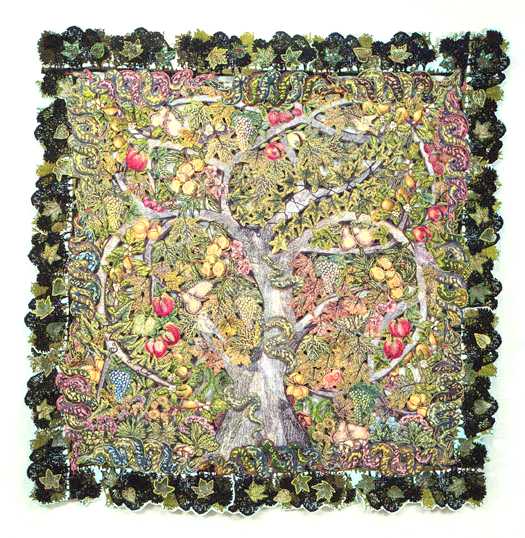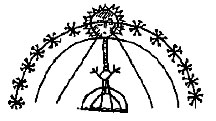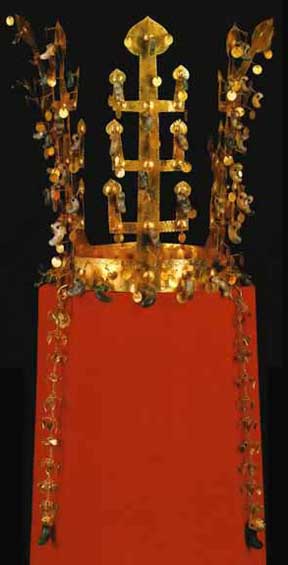DRAGON BALLS Rob Solàrion Dallas, Texas, 4 February 2001 Appended below are several diverse references to The Cosmic Tree from various websites. The following Chinese Legend of the Snake and the Pearl reminds me of two different, but related, stories. First of all, in the Sumerian Gilgamesh Epic, cited by Zecharia Sitchin and others, Gilgamesh travels to Egypt to recover a sacred talisman from a "dragon" that has stolen it and resides on the banks of the Nile. Gilgamesh is successful. When I worked in the Peace Corps in Eritrea, I investigated all sorts of "occult" and "mythological" beliefs, one of which dealt with a Legend of the Snake and the Pearl (see below). Thus, it is most fascinating to discover this legend replicated, more or less, in a Chinese variation. If I had to guess what it means, I would say that it reflects the fact that, just as the serpentine Chinese Dragon chases a pearl-like "Dragon Ball" in New Year's Day parades even today, the approaching Planet Nibiru and its "host" of planetoids and moonlets, a serpent-like procession through the Heavens, resemble a snake chasing a pearl. Why else would we have such legends in at least 3 different cultures? The Snake & The Pearl Once upon a time, somewhere in ancient Eritrea along the shores of the legendary Erythreum Sea, there lived an exotic serpent, the color of freshly polished ebony, a snake that slithered around the countryside from one village or town to the next. In order to find its way through life, the serpent carried in its mouth a lustrous white pearl that it had obtained somewhere from the depths of the ocean or on the sparkling shores of the Erythreum Sea. Without that pearl the snake could scarcely see, even during the light of day or at night during the times of a full moon. The snake would often become thirsty, though, and fatigued from its travels; and so upon coming to a pool of cool, clear water, it would place the pearl onto a stone or into a patch of soft green grass when it wanted to drink or to rest and refresh itself for a moment. But if when that ebony-colored snake were at peaceful repose, a clever man would happen to amble quietly down a nearby path and spy the snake and its precious pearl left unattended on a stone or in a patch of soft green grass, he could scoop up a handful of fresh cattle dung and hurl it onto the serpent's head. The cattle dung would momentarily totally blind the ebony snake, and the clever man could make off with the lustrous pearl. The snake would eventually recover its wits and would hiss and then retrace its path, though more cautiously than before, back down the precipitous mountain slopes and across the parched littoral plain to the sparkling shores of the Erythreum Sea, where, if the serpent were lucky and still young enough, it might someday find yet another pearl to guide its way by night and day back up to the pool of cool, clear water and onto the patch of soft green grass.
http://www.polenth.demon.co.uk/myth/favmyth.html#N NIE LANG was a human boy who lived with his mother in the Szechuan province of China. There was a drought in Szechuan, and Nie Lang had to cut grass for his master's horses every day. One day he could not find any grass. A white hare appeared and led him to a place of lush grass. Everyday he returned to cut more grass, and the grass regrew where he had cut it. One day he decided to take some of the grass home to plant, so that he did not have to walk so far everyday. When he dug the grass up, he found a pearl underneath which he also took. He planted the grass by his home, and put the pearl in an almost empty rice jar to cover its glow. The next day the grass was shriveled, but the rice jar was overflowing. The pearl gave Nie Lang and his mother more rice than they needed, so they shared it with their neighbours. Nie Lang's master, Lord Zhou, heard about the magic pearl and wanted it for himself. He and his guards came to Nie Lang's house looking for the pearl. Eventually Nie Lang swallowed it to stop the guards finding it, and the guards were chased away by Nie Lang's neighbours. The pearl felt hot inside him, so Nie Lang began drinking lots of water. Eventually he went down to the river to drink. When Lord Zhou and his guards returned to find him, Nie Lang rose out of the river -- he had transformed into a dragon. He sent a great wave that washed Lord Zhou and his guards away. Nie Lang the dragon ascended to heaven, and still watches over Szechuan today.
http://www.institute.uni-bremen.de/~ushanas/ 7. The standard as an image of a whim and the Cosmic Tree On the Indus seals the tree is replaced by a standard that is generally placed in front of the unicorn as already mentioned. The function of this standard is unknown so far. Its prototype is found together with a bull on a shard from Mehi in Baluchistan. The contrivance the bull is fastened to has roots here like a tree or plant. Its upper part has the appearance of a net normally, the lower part of a vessel. A small ivory sculpture of the standard, that has recently been excavated in Harappa, proves that it had a round form and holes in the lower part. On account of these features it could be a fire-drill, a mortar or a whim. Aladin's magic lamp in the story of 1001 nights is a variant of the fire-drill. When regarded as a whim the upper part could be a wind-blast. On the Mehi shard we simply find the frame. A Pipal Tree stands behind the standard here. The Pipal (ficus religiosa) has been venerated in India until today as the Cosmic Tree, though it suffocates other trees. Its fruits have berry-form and are sweet like dates. The purpose of the tree is to give shadow, but perhaps the standard was used for pressing these berries to get the sweet Soma juice or madhu.
http://www.san.beck.org/Upan7-Shveta.html SHVETASHVATARA UPANISHAD The beginning, the efficient cause of what is combined, it is to be seen as beyond the three times and timeless. Revere this as infinite, the origin of all being, the God of love who lives in one's own thoughts, the primal. Higher and different than the Cosmic Tree, time, and forms is this from whom proceeds all phenomena.
http://www.bahai-library.org/books/Hinduism/ch8.htm As we have seen previously (p. 00), Baha'u'llah has referred to the station of the Avatars and of himself in particular as the Tree of Life or the Tree beyond which there is no passing. In Hinduism there is also the concept of a cosmic tree. In the Bhagavad Gita it is written: There is an Eternal [Holy] Tree (Asvattha), with roots above in the highest and branches here below. Its leaves are sacred verses. He who knows it knows the Vedas. In his Most Holy Book and his Book of the Covenant, Baha'u'llah refers to himself as the Ancient (Pre-existent) Root of the Divine Tree; while `Abdu'l-Baha is the Most Mighty Branch, to whom all must turn after the passing of Baha'u'llah: 'When the ocean of My presence hath ebbed and the Book of My Revelation is ended, turn your faces toward Him Whom God hath purposed, Who hath branched from this Ancient Root.' The object of this sacred Verse is none other except the Most Mighty Branch [`Abdu'l-Baha]. Thus in the Baha'i writings, as in the Hindu, there is the concept of a cosmic holy tree (beyond which there is no passing); its root (Baha'u'llah) is in heaven; its branches (`Abdu'l-Baha and Shoghi Effendi, see below) stretch down towards earth; from this tree come sacred verses. The passage from the Bhagavad Gita quoted above indicates the importance of knowledge of this tree (the Covenant). It is the foundation of all religious knowledge. `Abdu'l-Baha passed away in 1921. He appointed his grandson, Shoghi Effendi as the Centre of the Religion. After Shoghi Effendi's death in 1957, the Universal House of Justice (see Chapter 6) was elected. This is now the Centre of the Religion and thus the focal point of loyalty to the Covenant for all Baha'is. Both `Abdu'l-Baha and Shoghi Effendi made every effort to spread the Baha'i Faith to all parts of the world. `Abdu'l-Baha sent numerous teachers from other parts of the Baha'i world to India in order to strengthen the Indian Baha'i community. He was planning to travel to India himself when unfortunately his death cut short these plans. Just as in Hinduism, there is a concept of cycles and ages, there is a similar concept in the Baha'i Faith. Baha'is believe that the coming of Baha'u'llah has started a new cosmic cycle. Although mankind has entered the Sat or Krta Yuga (Golden Age) foretold in Hindu prophecy, the full culmination of this Golden Age will only be achieved in stages similar to the Hindu ages. During this cycle, the Baha'i Faith will pass through various ages. At present, the Baha'i Faith is in its Transitional Age. This will lead in the end to the Baha'i Golden Age, the full expression of the Sat or Krta Yuga. This Golden Age will see mankind in a prosperous state, with no more war and the establishment of social justice. Eventually, Baha'u'llah teaches that there will come another Avatar, another Manifestation of God. But this will not occur for at least a thousand years. In the meantime, the responsibility of mankind is to put the teachings of Baha'u'llah into effect.
http://www.philtar.ucsm.ac.uk/encyclopedia/indon/batak.html Other symbols of Batak mythology include the baringin or banyan tree as the Cosmic Tree uniting the levels of the Batak cosmos, the hornbill, aboriginal boy-girl twins, star constellations, magic numbers, and the magic colours red, white, and black. Besides the traditional houses, these symbols are found on textiles, funerary masks, boats with hornbill figureheads, the wooden staffs of datu, and megalithic monuments. Adherents There are six major Batak societies around Lake Toba. These are the Toba Batak, Karo Batak, Pakpak and Dairi Batak, Simelungun Batak, Angkola and Sipirok Batak, and the Mandailing Batak. The Toba Batak are the only society which identifies strongly with being Batak. There are approximately 1.5 million Batak, of whom two-thirds are Christian, both Protestants and Catholics. The Protestants belong to the HKBP, which is the largest Christian community in Indonesia. The Muslim Batak mainly live in Mandailing. Headquarters/Main Centre The headquarters of the HKBP is at Tarutung in Toba, Sumatra, Indonesia.  http://www.museum.state.il.us/exhibits/changing/lintault/uncoil.html Evidence Of Paradise By M. Joan Lintault "Uncoiling Snakes" -- 1998 97 x 86 in. "Uncoiling Snakes" celebrates the tree of life, abundant with fruits, vegetables, mushrooms, insects, birds, and snakes that speak to the sanctity of life. It commemorates the "sacred tree", alluding to the variety of ways the tree has been revered, including the tree in the Garden of Eden, sacred groves, the cosmic tree, the tree in blue-willow pottery, and even the Christmas tree.
http://korea.insights.co.kr/see/see_2a.html Gold Crown Shilla, Fifth-sixth century Height 44.4cm National Treasure No. 87 National Museum of Korea This ornate crown is typical of the royal headdresses of Old Shilla. At front and rear are tree-like uprights decorated with gold spangles. Two antler-like uprights rise on the right and left. The tree and antler motifs are thought to originate in shamanism, symbolizing power and glory. The trees symbolize the cosmic tree which sustains the cosmos, and the antlers suggest sacred deer and the ancient worship of deer. From the base of the crown dangle pendants and clusters of leaf-like gold spangles.  http://www.theosociety.org/pasadena/popolvuh/pv-hp.htm Figure 7. The god of Heaven at the pinnacle of the cosmic tree, its "grace" falling upon the earth from on high, from the Chumayel manuscript. [Notice how the shape of this Mayan drawing resembles certain of The Hyperborea Sky Diagrams. Also, note that there is a total of 13 "stars", 6 on each side and a larger one at the top, in the station of the Mayan World Tree. Is it only coincidental that 21 December 2012 is day number 13.0.0.0.0.0 at the end of the current Tzolkin Calendar? By contrast, on the Korean Crown picture above, there are only 3 "tree-branches" on either side of the upper "star"; and in the Baluchistan drawing, there are 4 "leaves" below the uppermost "leaf". RS] |
